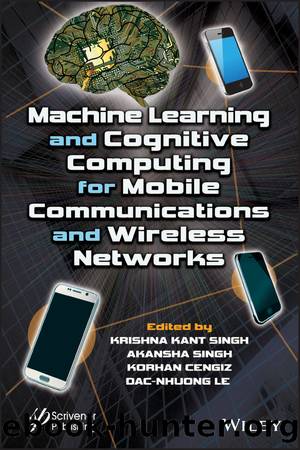Machine Learning and Cognitive Computing for Mobile Communications and Wireless Networks by Krishna Kant Singh & Akansha Singh & Korhan Cengiz & Dac-Nhuong Le

Author:Krishna Kant Singh & Akansha Singh & Korhan Cengiz & Dac-Nhuong Le [Krishna Kant Singh]
Language: eng
Format: epub
Publisher: Wiley-Scrivener
Published: 2020-07-07T16:00:00+00:00
The existence of CRNs depends on the ability of CR nodes to decide sense and decide the available spectrum spaces. The placement of such channel sensing, selection/decision and other related performance optimization algorithms is a challenge for researchers. Centralized and distributed are two modes of operation for CR systems. Several sensing and allocation/decision algorithms have been discussed in this chapter. However, their customized or modified forms are being developed to resolve the issues related to performance improvement and implementation in unexplored application areas. The extensive growth of machine learning has helped the CR nodes in various aspects of cognitive cycle. The choice of supervised or unsupervised learning is the first challenge faced while making a suitable decision for adopting machine learning algorithms. The design and implementation of such algorithms may further increase the complexity of CR systems. Another challenge is associated with implementing geo-location technology which is by CR systems to find and track the location of mobile PUs and SUs, thus contributing to estimation of resource requirement and availability of spectrum holes or chances of a PU entering the coverage area of an SU. The challenges are related to implementation and use of database along with acquiring accurate location of CR nodes. It becomes more challenging in case of the nodes which are not equipped with GPS.
Security of devices and users (identity and data) are the foremost requirements for any network based system. This also includes compliance of regulations. The related challenges include device access authorization, attempts of violation and potential threats, security certifications of software resources and presence of malicious software in the device. Front-end of CR nodes is another major source of challenges faced by CR designers. This includes frequency agile transceivers with wide-band operation, low noise amplifier (LNA) with high linearity in wide band and impedance matching for a variety of device outputs. The ADC and DAC are integral parts of CR systems since processing within the CR devices is conducted in digital domain whereas the RF signal at the front-end is analog. The need to operate these ADC and DAC over a wide spectrum and at several power levels is a challenge for researchers. Other related challenges are calibration of channel mismatch for difference spectrum bands occupied by CR nodes at different times and skew error correction in sensing and front-end tuning [101]. Techniques such as post-linearization in digital domain and interleaving time and frequency multiplexing using set-pass sampling filter are being used to reduce complexity, increase sensitivity with less imperfections. The design issues at base-band level architecture include flexible operation with optimized tradeoff between power consumption and performance. This demands for reconfigurable resources, efficient power management schemes and dynamic task management.
The issues and challenges highlighted are crucial for effective deployment of CRNs for real-time communication systems. The challenges are multiple depend upon the usage scenarios and bounds of physical systems. Further research is required to develop algorithms, protocols and schemes which can resolve the issues and challenges faced by the current implementation of CRN and future technologies.
Download
This site does not store any files on its server. We only index and link to content provided by other sites. Please contact the content providers to delete copyright contents if any and email us, we'll remove relevant links or contents immediately.
Algorithms of the Intelligent Web by Haralambos Marmanis;Dmitry Babenko(8517)
Test-Driven Development with Java by Alan Mellor(7332)
Data Augmentation with Python by Duc Haba(7236)
Principles of Data Fabric by Sonia Mezzetta(6981)
Learn Blender Simulations the Right Way by Stephen Pearson(6913)
Microservices with Spring Boot 3 and Spring Cloud by Magnus Larsson(6746)
RPA Solution Architect's Handbook by Sachin Sahgal(6150)
Hadoop in Practice by Alex Holmes(6026)
Jquery UI in Action : Master the concepts Of Jquery UI: A Step By Step Approach by ANMOL GOYAL(5865)
The Infinite Retina by Robert Scoble Irena Cronin(5852)
Big Data Analysis with Python by Ivan Marin(5686)
Life 3.0: Being Human in the Age of Artificial Intelligence by Tegmark Max(5395)
Pretrain Vision and Large Language Models in Python by Emily Webber(4645)
Infrastructure as Code for Beginners by Russ McKendrick(4428)
WordPress Plugin Development Cookbook by Yannick Lefebvre(4157)
Functional Programming in JavaScript by Mantyla Dan(4116)
The Age of Surveillance Capitalism by Shoshana Zuboff(4108)
Embracing Microservices Design by Ovais Mehboob Ahmed Khan Nabil Siddiqui and Timothy Oleson(3947)
Applied Machine Learning for Healthcare and Life Sciences Using AWS by Ujjwal Ratan(3920)
